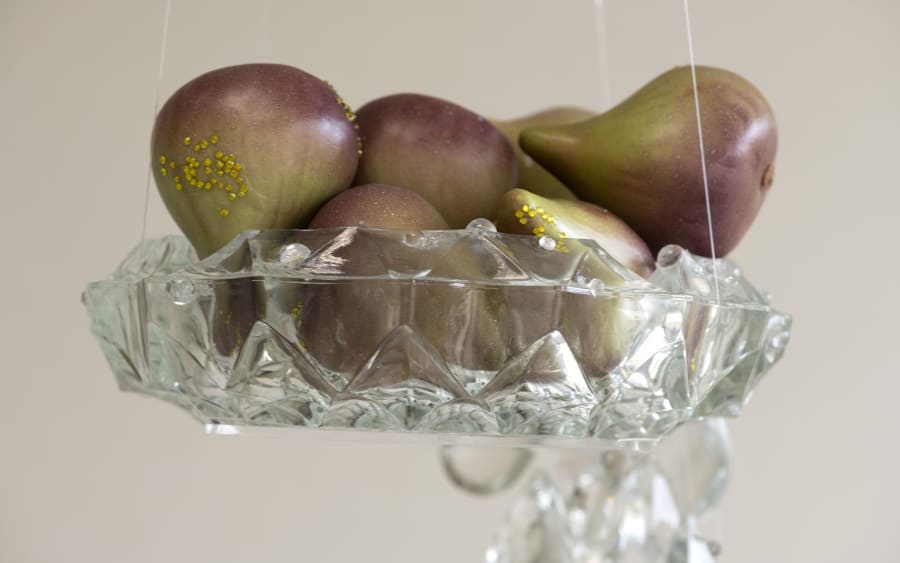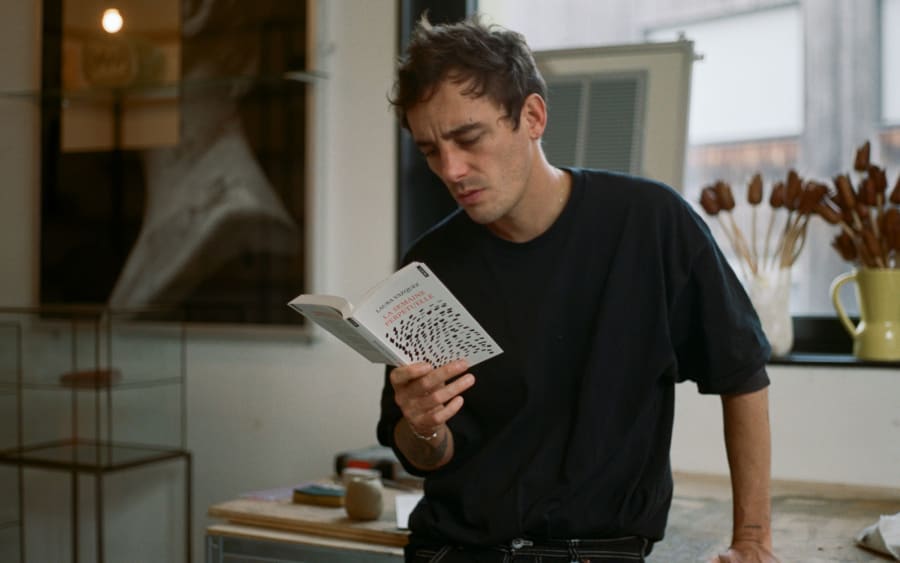Two figures emerge from a sea of cardboard boxes. They touch, embrace, and sensually tear away the latex suits that bind them, freeing their movements amid the detritus that surrounds them as a third figure looks on. The scene raises questions: Is this theater? Dance? Performance art? A living exhibition? The answer, as with much of Théo Mercier’s work, is it is all of these at once. Presented at the Festival d’Automne last November, Skinless exemplifies the ambiguity the artist has cultivated over the past 15 years, moving between the art and performance worlds without ever being confined to either.
Mercier’s portfolio defies easy categorization. His works range from a field of cars erected vertically, as if frozen mid-accident, to sculpted busts bound using the Japanese bondage technique of shibari, and dancers’ bodies perched on ladders – all products of his remarkable work as both sculptor and director. Crucially, the 40-year-old artist is also a producer and fabricator, adding to a skill set that earned him recognition as a contemporary art wunderkind early on.
Clean and orderly, his studio in Paris’s 20th arrondissement looks more like a showroom than a production space. The shelves display African tribal statues, fossils, skulls, and foot molds, while small stones of various shapes line the windowsills. His signature pieces are also present: sculptures composed of stacked polished stones and amphoras placed on spring pedestals, large shells containing printed texts. It’s a veritable arsenal of deliberately anachronistic artifacts, crossing ancestral and pop cultures, revealing a clear taste for subversion. Mercier is an avid collector, and the organized studio betrays a keen interest in exhibition venues as places of both transmission and power.
Mercier’s entry into the art world came precociously and auspiciously. After earning his industrial design degree from the École nationale supérieure de création industrielle (National Higher School of Industrial Creation) in Paris and working in the fashion designer Bernhard Willhelm’s studio, he found his true calling during an 18-month apprenticeship with the artist Matthew Barney in New York. ‘He revealed to me an artist’s full potential,’ Mercier reflects. ‘Here was someone creating sculpture, film, performance, opera – all with equal precision and ambition. He’s a world-builder.’ Following Barney’s example, Mercier set out to construct his own boundless artistic universe.
His early works demonstrate his mastery of synthetic materials like silicone and resin, often manipulating them into strange, humorous forms – heads composed of flowing hair and bones, mouths brimming with teeth. During this ‘pop sculptor’ phase, as he now describes it, Mercier used his playful creations to probe with darker questions about contemporary life. Le Solitaire (The Solitary) (2010), one of his breakthrough pieces – a giant figure made of spaghetti, reimagining Rodin’s The Thinker – exemplifies this approach. Its presentation at the FIAC art fair in the French capital that year marked Mercier’s arrival in the art market at just 26.
Seeking distance from his early success in France, the artist departed for Mexico and fell in love with the country, where he would live for eight years. Inspired by its lush landscapes, he deepened his experiments with rock, sand, and sea, exploring local craft techniques, always aiming to ‘make the invisible visible and bring forth what is buried.’ During this period, the Parisian produced dozens of totemic sculptures that seemed on the verge of collapse, stacking small figurative objects, ceramics, and stones sourced locally – pieces now highly sought after by collectors.
A voracious reader, Mercier collects words as avidly as objects. These found their way into his first play, Du futur faisons table rase (Let’s Make a Clean Slate of the Future), written during a pivotal residency at Villa Medici in 2013-14. Described by the quadragenarian as ‘chaotic, crazy, and super-messy,’ this collective work brought together several artists he admires, including the dancer François Chaignaud and the singer Philippe Katerine, to stage a multilayered reflection on art history. Unveiled at the Maison des arts de Créteil, the project marked Mercier’s entry into the performance world – again through the front door – as it was subsequently programmed at the prestigious Théâtre des Amandiers in Nanterre, just west of Paris.
In the performing arts, Mercier has found his element. ‘It’s a unionized environment that relies heavily on public funding,’ he notes, ‘much more inspiring than the neoliberal model – or rather non-model – of contemporary art.’ His productions, from Radio Vinci Park (2016) to La fille du collectionneur (The Collector’s Daughter) (2017), explore human relationships’ beauty and violence with characteristic poetic wit. Like Barney and the theater director Romeo Castellucci, another of his role models, Mercier creates everything: the libretto and spatial arrangement, of course, but also the sets, costumes and lighting, all bearing the hallmark of his versatile touch. To better manage his flourishing – and increasingly ambitious – output, the Frenchman established a structure that sits somewhere ‘between a studio and theater company’ with a creative and production team, now split for nearly 10 years between three people supporting his visual art endeavors and two people managing his stage productions.
‘My work on stage has completely transformed my approach to sculpture and exhibition-making,’ Mercier says. His installations have evolved into what he terms ‘environments’ – spaces where his ‘dramatic’ objects coexist. Like the cabinets of curiosities he installed at Paris’s Museum of Hunting and Nature in 2019, mixing shells with protruding hands, suspended tires and round stones imitating breasts. Through their theatrical arrangement, the artist seeks to break free from the exhibition space to find what he calls a ‘gray zone’ – interstitial and ambiguous – in which to bring his own universe to life.
This is evidenced by his long-term project Outremonde, begun in 2021 as a show at the Festival d’Avignon, then adapted into a ‘living exhibition’ at the Collection Lambert in the city. The work presents compressed sand formations where sculpted dogs, architectural ruins, punctured mattresses, and live performers intersect in a three-chapter narrative of reconstruction. This ambitious project, later shown at Paris’s Conciergerie, sparked a new methodology: Rather than transporting materials, Mercier now recreates his sets on-site using locally sourced materials. ‘My work has always been deeply connected to local economies,’ he says. ‘I want it to reflect my experience of each place – how I work there and with whom.’
Thus, for the past five years, Mercier’s team has been traveling to performance venues ahead of his shows to recreate his sets in situ. This process defines Skinless, which was presented at La Villette for the Festival d’Automne 2024: On a platform encircled by standing viewers, three performers engage in choreographed dialogue amid domestic waste. In each tour city that the work has been presented this year, from Brest to Lausanne, Mercier’s team borrowed tons of food packaging from recycling companies, using it temporarily before returning it intact. ‘Materials must enter and exit my work unchanged,’ Mercier says. ‘I’m interested in hacking systems of production and destruction, slightly subverting them through my work. It’s my industrial designer side, throwing a wrench in the conveyor belt.’
Though the piece presents a dystopian vision, Mercier insists it carries profound tenderness, speaking simultaneously to ‘a damaged world’ and ‘a new world coming, full of hope.’ More optimistic – even idealistic – than his work might suggest, he concludes: ‘What truly interests me is living, traveling, falling in love. Everything I do in my work is simply a pretext for that.’
Théo Mercier is represented by mor charpentier (Paris, Bogotá).
Skinless
From November 21 until December 8, 2024
Festival d’Automne, Paris
‘Méditerranées’
Permanent exhibition
MUCEM, Marseille
Matthieu Jacquet is a journalist and art critic writing for Numéro, Numéro art and Geste/s.
English translation: Art Basel.
Caption for header image: Théo Mercier’s studio, photograph by Marion Berrin for Art Basel.
Published on November 19, 2024.


